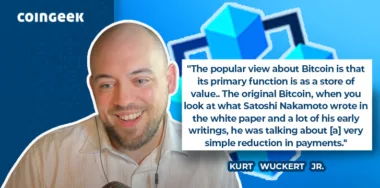SLictionary Co-Founder John ‘Jack’ Pitts joined the CoinGeek Weekly Livestream this week to discuss COPA v Wright, Bitcoin SV, and more.
Let’s not talk about COPA (yeah, right!)
Wuckert begins by saying he’s recovering from surgery well and would like to talk about something other than COPA v Wright. Of course, that doesn’t happen, and most of the Weekly Livestream is about it or related topics.
Kicking things off, Wuckert notes how Pitts has put together some excellent threads on COPA v Wright. Whereas Wuckert has been taking a direct approach, transcribing and paraphrasing, Pitts has been adding his own commentary.
#copa v. Dr. Wright, Day 8:
"It's Toasted"
[WTF?}It's the greatest line from the best TV show ever made, in the best episode of the show: Season 1, Episode 1, @MadMen_AMC.#btc Core's lawyer thought he won, but he really was toasted & their victory laps were with eyes shaded. https://t.co/ZpfbA8Jb5N pic.twitter.com/XbdBnE25ot
— John Pitts (@EquityDiamonds) February 14, 2024
Pitts points out that the barrister for COPA will not let Dr. Wright elaborate and explain too much when he gets going. He quickly moves on to the next question and shuts him down whenever possible. He’s afraid to wade into Dr. Wright’s territory. It appears COPA is avoiding topics that could reveal Dr. Wright’s technical superiority and expertise.
Wuckert laughs at the laser-eyes cult who think COPA is killing Dr. Wright on the stand. To him, it looks like a lot of punches are being thrown, but none are connecting. In fact, having witnessed multiple trials, he’s sure this is the worst performance by any attorney/barrister to date.
What about that watermark?
Pitts says he doesn’t expect Dr. Wright to fire a silver bullet such as moving coins, revealing a watermark, or printing Bitcoin.org receipts. Even if he has them, he’ll hold back, he says.
While he seems to be enthusiastic about steganography, that could be something random and unrelated. After all, Dr. Wright wasn’t planning on being sued back in 2008, so it’s unlikely he has kept pristine evidence just for an occasion like this.
Even if you have the best cards in poker, you don’t go all in right away, Pitts rightly says. However, even if Dr. Wright doesn’t win, the BSV blockchain ecosystem can grow in time—winning would just make it happen faster.
A brief overview of the halving and what it means for Bitcoin
Finally, a change of topic via a viewer question! Wuckert explains that Bitcoin was issued with a fixed distribution schedule. Every 210,000 blocks, the number of new coins in each block is halved.
After the next one, which is coming up fast, there’ll be 3.125 coins in each block. He calls this “Satoshi’s ticking time bomb,” highlighting the need for transactions to replace the block subsidy.
Pitts says he was interested in speculation in 2012, and it’s through studying the halving cycle (among other things) that he began to understand Bitcoin. On the price appreciation that usually happens after it, he says that eventually, it isn’t going to work. If the shoeshine boy says it’s time to buy a stock, don’t do it, he says, paraphrasing legendary trader Jesse Livermore. While the price could appreciate again after this halving, Pitts wouldn’t bet on it.
Check out Wuckert’s latest CoinGeek article
With the revelations that Dr. Craig Wright’s computer systems were compromised, his enemies have been trying to paint him as an incompetent security expert and a liar.
However, Wuckert has written an article titled ‘Who gets hacked like this?‘ detailing how even the most secure systems can be compromised and how industrial espionage is a fact of life. He reminds viewers to check it out.
To hear more about Pitts and Wuckert’s thoughts on mining profitability, locking coins, and some of the characters involved in Dr. Wright’s ongoing saga, check out this episode of the CoinGeek Weekly Livestream here.
Watch: Exchange corruption and CZ fines, COPA trial, Mining Bitcoin and Halving
New to blockchain? Check out CoinGeek’s Blockchain for Beginners section, the ultimate resource guide to learn more about blockchain technology.










